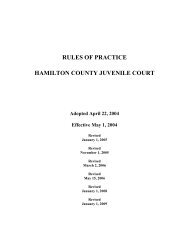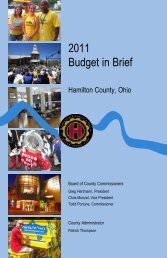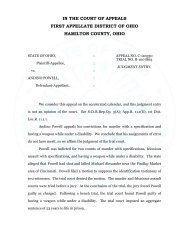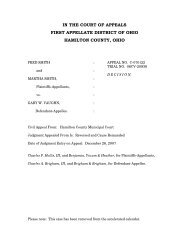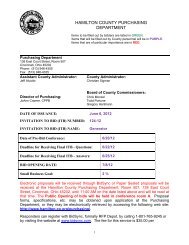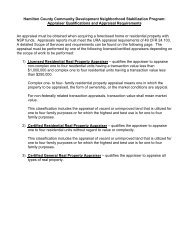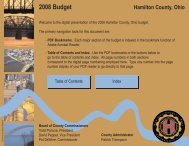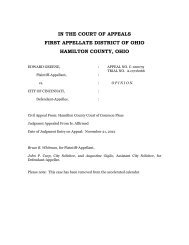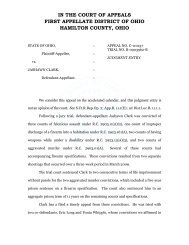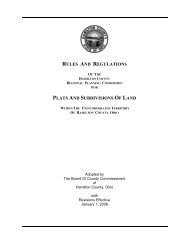Planning Commissioners' Procedures Manual - Hamilton County, Ohio
Planning Commissioners' Procedures Manual - Hamilton County, Ohio
Planning Commissioners' Procedures Manual - Hamilton County, Ohio
You also want an ePaper? Increase the reach of your titles
YUMPU automatically turns print PDFs into web optimized ePapers that Google loves.
Zoning - The Relationship of <strong>Planning</strong> to Zoning<br />
http://ohioline.osu.edu/cd-fact/0303.html<br />
In 1947, the <strong>Ohio</strong> General Assembly passed enabling legislation that allows cities, villages, counties, and<br />
townships to establish zoning. The procedures and methods and procedures to establish zoning are<br />
distinct. However, the content is the discretion of the people of the area. <strong>Ohio</strong>'s law is very precise and<br />
detailed. The law is designed to involve the public in the zoning process.<br />
Zoning regulation can be divided into two categories: unincorporated (rural) and municipal. This series of<br />
fact sheets will focus on rural zoning. Rural zoning concentrates on township and county zoning outside<br />
of municipalities (village, town, city).<br />
Township zoning is the responsibility of township trustees. <strong>County</strong> zoning falls into the jurisdiction of the<br />
county commissioners. <strong>County</strong> zoning may include all or any number of townships in the county. <strong>County</strong><br />
zoning includes a uniform zoning text administered county- wide. All zoning issues are accepted or<br />
rejected by referendum.<br />
There is confusion about comprehensive planning and the zoning process. The two terms have often been<br />
used interchangeably even though they are distinctly different. Comprehensive planning attempts to plan<br />
and relate land uses within an area to an overall development pattern. A comprehensive land use plan can<br />
only be developed after a thorough study of the area, i.e. township or county, and the interactions of its<br />
social, economic, and physical parts. This information is essential for the development of a<br />
comprehensive plan that will guide future growth.<br />
The comprehensive plan is part of the broader planning process which includes setting goals and<br />
objectives, decision making, inventory, tools for implementation. Before a comprehensive plan can be<br />
implemented, an inventory of the current situation must be assessed. The inventory should include<br />
population and economic base information, transportation, current land uses, and community<br />
infrastructure. The goal setting or "decisions for the future" process utilizes the inventory data to set<br />
objectives and goals. Goals and objectives for future use will influence the tools for implementation, of<br />
which zoning is one of the tools.<br />
The comprehensive plan presents a long-range statement for the future. The comprehensive plan is<br />
general in designating boundaries. It is rarely a period of less than ten years and usually includes a twenty<br />
or more year span. The comprehensive plan can be adopted as a legal document but has the primary<br />
function of serving as a guide to advise the community on specific decisions.<br />
Zoning is more specific in nature because it indicates the use of each land parcel within a township or<br />
county area, excluding incorporated communities. Zoning regulations address location, height, bulk,<br />
number of stories, size of buildings, and percentage lot coverage in each zone or district in the political<br />
subdivision. Zoning is one of several legal devices for implementing the proposals and objectives for land<br />
development as outlined in the comprehensive plan. To be effective, the zoning ordinance and map<br />
should be directly related to a previously prepared and adopted land use plan. Zoning plans encompass<br />
those needs in a limited amount of time, often a 5 to 10 year period.



